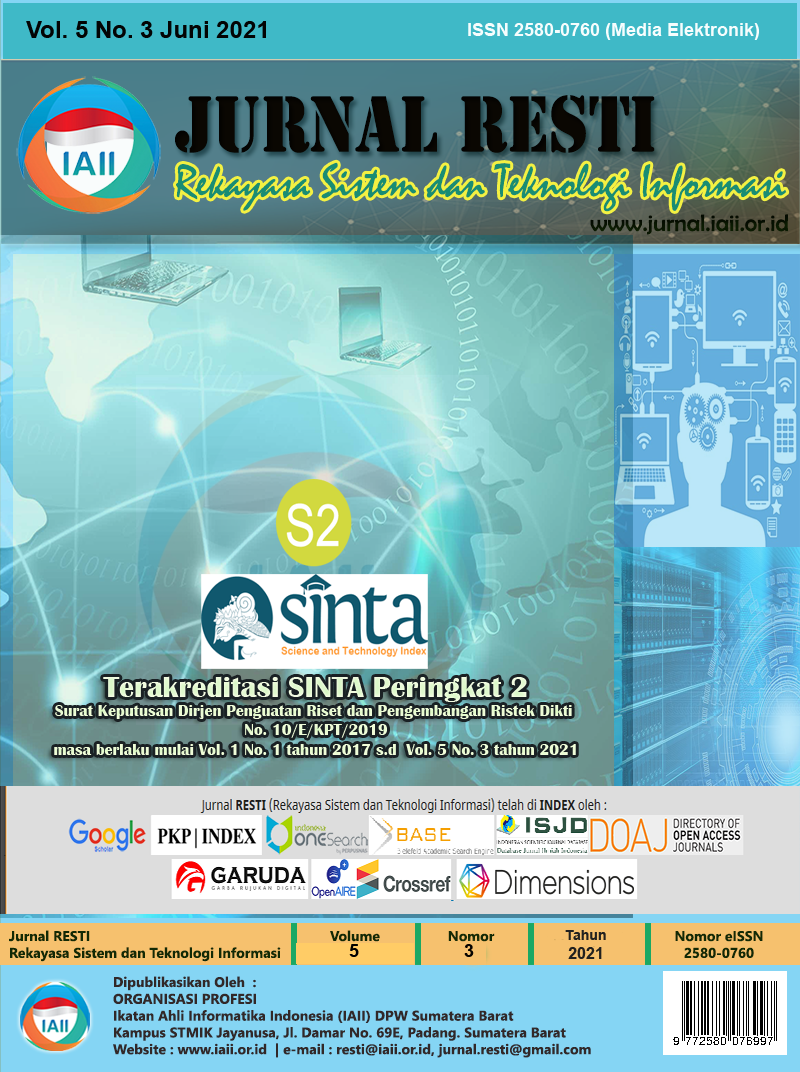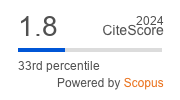Klasifikasi Data Aktivitas Setelah Joging Menggunakan Fuzzy Logic
Abstract
One of the routine activities that cause a lot of body fluids is jogging. Research shows that excessive jogging can disrupt the balance of body fluids so that you tire quickly in the long run. As a result, the body releases too much fluid. This makes someone forget or underestimate the need for fluids in the body. In this study, a detection system for body temperature, ambient temperature and heart rate was built for the classification of dehydration in the body to maintain fluid stability in the body. The system is built using the Pulse Sensor, Mlx90614, OpenWeatherAPI and the Android Platform. This study uses the Mamdani Fuzzy Logic method to determine the classification of user dehydration. The results of the research analysis contained a calibration test of the MLX90614 sensor against the Thermogun with an Error Rate value of 2.01% and an RMSE value of 0.9. Testing the Pulse Sensor against the Oximeter produces an Error Rate value of 1.54% and an RMSE value of 0.7. There is a difference in the difference in Deffuzification values due to differences in the fixed points for each library. Matlab fixed point with a value behind the three digit point, 16 digit Fuzzy Sci-kit and the Builded System using a 15 digit point value.
Downloads
References
H. Hardinsyah et al., “Studi Kebiasaan Minum dan Hidrasi pada Remaja dan Dewasa di Dua Wilayah Ekologi yang Berbeda,” Pergizi Pangan Indones. Dep. Gizi Masy. IPB, Danone Aqua Indones., pp. 1–5, 2008.
Y. Noor, S. Ulvie, H. S. Kusuma, and R. Agusty, “Identifikasi Tingkat Konsumsi Air dan Status Dehidrasi Atlet Pencak Silat Tapak Suci Putra Muhammadiyah Semarang,” Media Ilmu Keolahragaan Indones., vol. 7, no. 2, pp. 48–51, 2017, doi: 10.15294/miki.v7i2.12146.
A. Grisna, Febiyanti; Kunjung, “Perbandingan Jenis Pola Minum Terhadap Status Hidrasi Pada Remaja Laki-Laki Dan Perempuan,” vol. 4, no. 2, 2019.
I. T. Rahayu, “Pengaruh Jogging Pagi hari dan Malam Hari terhadap Kadar Asam Laktat pada Mahasiswa Ikor FIK UNNES,” Skripsi Jur. Ilmu Keolahragaan, Fak. Ilmu Keolahragaan, 2016, [Online]. Available: https://lib.unnes.ac.id/27276/1/6211411043.pdf.
I. N. E. A. Khrisna, “Keseimbangan Cairan Dan Elektrolit Oleh:,” Вестник Росздравнадзора, vol. 6, pp. 5–9, 2017.
A. Auliani, A. G. Putrada, and N. A. Suwastika, “Perancangan dan Implementasi Sistem Monitoring Suhu Pemantau Dehidrasi Berbasis Fuzzy Logic dan IOT,” e-Proceeding Eng., vol. 6, no. 1, pp. 2257–2267, 2019, [Online]. Available: https://openlibrary.telkomuniversity.ac.id.
R. Syahputra, M. Abdurohman, and S. P. S. T, “Pendeteksi Kelelahan Untuk Aktivitas Jogging Menggunakan Fuzzy Logic,” Telkom Univ., vol. 16, p. 3, 2019.
A. Pranata, J. Prayudha, and T. Sandika, “Rancang bangun alat pendeteksi dehidrasi dengan metode fuzzy logic berbasis arduino,” J. SAINTIKOM, vol. 16, no. 3, pp. 252–259, 2017.
A. R. Suprabaningrum and F. F. Dieny, “Hubungan konsumsi cairan dengan status hidrasi pekerja di suhu lingkungan dingin,” J. Nutr. Coll., vol. 6, no. 1, p. 76, 2017, doi: 10.14710/jnc.v6i1.16896.
R. Siti, Komariyah; , Riza M., Yunus;Sandi Fajar, “Logika Fuzzy Dalam Sistem Pengambilan Keputusan Penerimaan Beasiswa,” pp. 61–69.
N. Febriany, F. Agustina, and R. Marwati, “Aplikasi Metode Fuzzy Mamdani Dalam Penentuan Status Gizi Dan Menggunakan Software Matlab,” J. EurekaMatika, vol. 5, no. 1, pp. 84–96, 2017.
Y. Maryani, “Kalibrasi Dan Validasi Sensor Sebagai Alat Ukur Gas Co 2 Yang Dihasilkan Pada Proses Fotokatalisis Senyawa Aktif Detergen,” Tek. J. Sains dan Teknol., vol. 7, no. 2, p. 102, 2011, doi: 10.36055/tjst.v8i2.6709.
D. R. Agusta, S. Prabowo, and N. A. Suwastika, “Implementasi Emergency Light untuk Jalur Evakuasi Terdekat Saat Gempa Menggunakan Algoritma Greedy Search,” vol. 6, no. 2, pp. 8921–8930, 2019.
C. D. N. Tulle, “Monitoring Volume Cairan Dalam Tabung ( Drum Disusun Oleh : Christian Dendi Novian Tulle,” vol. C, 2017.
Bluino, “Apa itu Arduino?,” 2019. https://www.bluino.com/2019/09/apa-itu-arduino_13.html (accessed Dec. 16, 2020).
H. H. Rachmat and D. R. Ambaransari, “Sistem Perekam Detak Jantung Berbasis Pulse Heart Rate Sensor pada Jari Tangan,” ELKOMIKA J. Tek. Energi Elektr. Tek. Telekomun. Tek. Elektron., vol. 6, no. 3, p. 344, 2018, doi: 10.26760/elkomika.v6i3.344.
M. O. Sibuea, “Pengukuran Suhu Dengan Sensor Suhu Inframerah Mlx90614 Berbasis Arduino Temperature Measurement With Infrared Temperature Sensor Mlx90614 Based on Arduino Uno,” Univ. Sanata Dharma, 2018.
S. Canada, “Canadian Health Measures Survey : Cycle 2 Data Tables – 2009 to 2011 Distribution of the household population by aerobic fitness norms , by age and sex , Canada , 2009 to 2011 Statistics Canada – Catalogue no . 82-626-X,” no. 82, p. 2011, 2011.
I. Annisa Amalia, “Suhu Tubuh Normal Manusia yang Benar Seharusnya Berapa?,” 2020. https://www.sehatq.com/artikel/bukan-derajat-celsius-ini-suhu-tubuh-normal-manusia-yang-benar (accessed Dec. 08, 2020).
BMKG, “Anomali Suhu Udara Rata-rata Bulan November 2020,” 2020. https://www.bmkg.go.id/iklim/?p=ekstrem-perubahan-iklim#:~:text=Berdasarkan data dari 88 stasiun,udara rata-rata pada bulan (accessed Dec. 08, 2020).
M. Mahyudin, I. Suprayogi, and T. Trimaijon, “Model Prediksi Liku Kalibrasi Menggunakan Pendekatan Jaringan Saraf Tiruan (ZST) (Studi Kasus : Sub DAS Siak Hulu),” J. Online Mhs. Fak. Tek. Univ. Riau, vol. 1, no. 1, pp. 1–18, 2014.
Copyright (c) 2021 Jurnal RESTI (Rekayasa Sistem dan Teknologi Informasi)

This work is licensed under a Creative Commons Attribution 4.0 International License.
Copyright in each article belongs to the author
- The author acknowledges that the RESTI Journal (System Engineering and Information Technology) is the first publisher to publish with a license Creative Commons Attribution 4.0 International License.
- Authors can enter writing separately, arrange the non-exclusive distribution of manuscripts that have been published in this journal into other versions (eg sent to the author's institutional repository, publication in a book, etc.), by acknowledging that the manuscript has been published for the first time in the RESTI (Rekayasa Sistem dan Teknologi Informasi) journal ;








